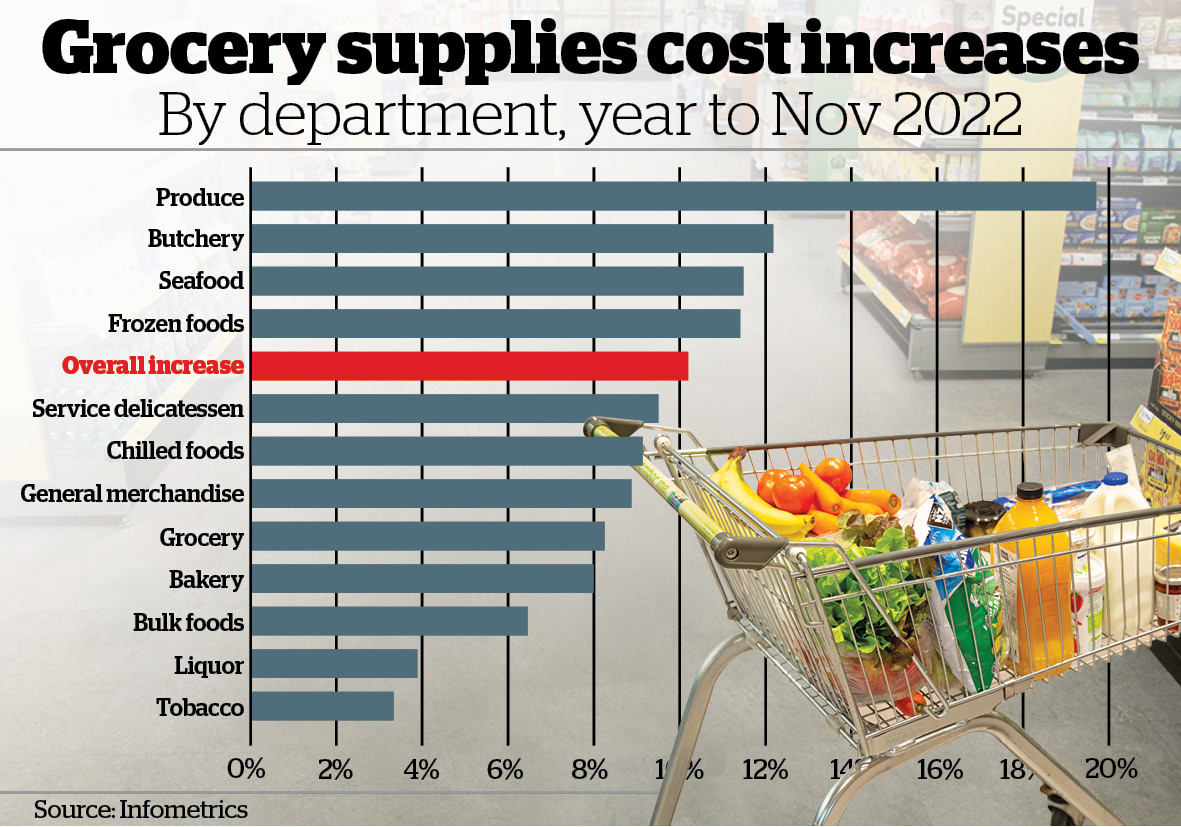Supermarket supply costs have risen just over 10 per cent in a year, with the cost of fresh produce up by almost 20 per cent, according to an Infometrics report. Photo / NZME
Northland’s low-income households will be hardest hit by continued steep increases in the cost of grocery supplies, a top economist says.
The latest Infometrics figures show goods supplied to the Foodstuffs supermarket chain were 10.2
per cent more expensive last month than in November 2021.
That compares to a figure of 10.0 per cent for the year to October 2022, and 9.2 per cent a month earlier. The figure for November 2019 was just 1.8 per cent.
While the Infometrics-Foodstuffs Grocery Supplier Cost Index is not the same as the inflation consumers feel in their pockets, supplier costs make up about two-thirds of supermarket shelf prices, so the two figures tend to follow each other closely.
StatsNZ is due to release the country’s latest inflation figures today.
Brad Olsen, Infometrics’ principal economist, said it wasn’t just the stubbornly high rate of supplier cost increases that stood out, it was also the sheer number of items – 7800 – which had gone up in price.
That was about three times the pre-pandemic number, and beaten only by the previous month’s all-time record of about 9000 items.
Olsen said the biggest increases were in fresh food, with produce up almost 20 per cent since November last year, and meat and seafood also significantly more expensive.
Advertisement
That made sense because on-farm costs, such as diesel and fertiliser, had gone up at their highest rate since the 1990s.
While shoppers were familiar with produce prices being volatile due to factors such as weather, the current cost increases were broad-based and also affected general groceries such as tinned food, and even items such as two-minute noodles, which infamously went up by 37 per cent in the year to October 2022.

Olsen said factors contributing to cost increases included higher transport and production costs, the high price of diesel, a tight labour market — “It’s difficult to find staff, and expensive when you do” — and a weaker New Zealand dollar lifting the price of imported goods.
Global factors included shipping costs, soaring energy prices in Europe and higher grain prices due to the Russian invasion of Ukraine.
“The most challenging thing at the moment is that it’s all of those things. Everyone asks, ‘What’s causing it?’, but a better question might be, ‘What’s not causing it?’”
/cloudfront-ap-southeast-2.images.arcpublishing.com/nzme/X4HWN2RESJDONPCPCBXLH7Z2EI.JPG)
Olsen said low-income households in particular were feeling the pinch.
“People who’ve been trying to keep their costs down any way they can are now very much feeling the broad effects of inflation hitting them at every turn. The broadening of these supplier cost increases is really challenging, because it’s difficult to eat healthily when produce is so expensive, but it’s difficult to eat in general if two-minute noodles are more expensive as well.”
Olsen, who hails from Whangārei, said rising prices were a double-edged sword for Northland.
Advertisement
“A number of people across the North struggle to put food on the table. At the same time, the region has strong economic fundamentals, with food and beverage producers benefitting from higher prices. However, they’re also facing some hefty cost increases, so they’re not creaming it.”
/cloudfront-ap-southeast-2.images.arcpublishing.com/nzme/G72H53KKMR22SZXL4SDEN5ZTX4.jpg)
Surging food prices have not only put a squeeze on low-income Northlanders, but also on the organisations trying to make sure they don’t go without, especially as Christmas approaches.
It has also led to some innovative solutions, such as the social supermarkets now springing up around Northland.
Social supermarkets are laid out like normal grocery stores but, instead of using money, clients are granted a certain number of points, depending on their circumstances, which they use to ‘buy’ the items they need.
The idea is that wastage is reduced, because clients take home only the items they need instead of a pre-packed food parcel, and both their dignity and ability to choose is preserved. It also provides an opportunity for agencies to offer other kinds of assistance.
Northland’s first social supermarket, Te Hiku Pataka, opened in Kaitaia in June, the result of a partnership between Foodstuffs North Island and iwi collective Te Kahu Oranga Whānau.
Social services provider 155 Whare Āwhina opened Whangārei’s first social supermarket on Woods Rd in September, also in partnership with Foodstuffs North Island.
It will replace the 90-150 food parcels the organisation used to provide each week through its Whangārei food bank.
On January 11, the Salvation Army plans to open its first Choice Supermarket, which will operate along similar lines to its Aubrey St premises in Whangārei.
The Infometrics report delivers a few snippets of good news, such as the price of diesel falling to its lowest price since the mid-April peak. However, it is still up by 29 per cent since November 2021.
It also shows global food prices have stabilised, though that has yet to flow through the supply chain and is offset by a lower New Zealand dollar.
And, happily for Northland coffee lovers, the supply cost of coffee fell in the year to November 2022 — one of the only products to do so.
The Foodstuffs supermarket chain includes Pak’nSave, New World and Four Square.



